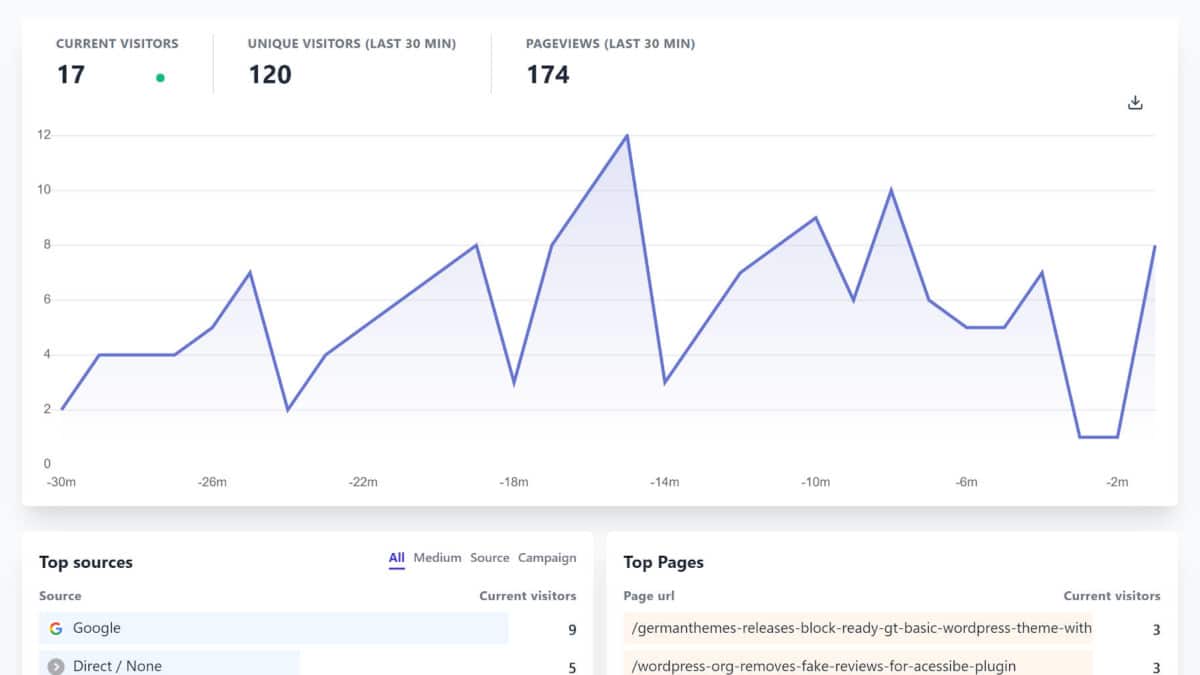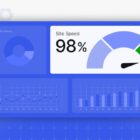Plausible Analytics is not new on the scene. The two-person, EU-based team behind the company has been trying to carve its slice of the analytics pie against players like Google Analytics and WordPress.com Stats for nearly two years.
The self-funded and bootstrapped company is starting to gain a small foothold. It has been an uphill climb to get to usage on over 10,000 websites. Now, it is reaching out directly to the WordPress community with its Plausible Analytics plugin.
“Plausible Analytics is a simple, open-source, lightweight (< 1 KB), and privacy-friendly alternative to Google Analytics,” said co-founder Marko Saric. “We don’t use cookies or track any personal data, but we still aim to give you as a site owner interesting and useful insights so you can improve your efforts.”
The company’s service is built on an open-source philosophy, possibly making it an ideal partner for WordPress. The source code for the analytics service is licensed under the AGPL version 3.0 and is publicly available on GitHub.
Users have two options for running Plausible Analytics. The first route is to use the company’s cloud-based service, similar to other stats-based services. The other is to self-host the code.
For the cloud service, there is a monthly, tier-based fee. Up to 10,000 pageviews runs $6 per month. Each level increases based on the number of views a site — you can also hook up multiple sites — receives. Users can knock 33% off the price by paying yearly, which puts the starting tier at $4 per month. Plausible also offers a 30-day free trial.
“It’s definitely a challenge to go against free products and a product as dominant as Google Analytics, but it does feel like the times are changing,” said Saric. “An increasing number of people are becoming aware that free means that you may be paying with something else such as the data of your visitors in the case of Google Analytics.
“With Plausible, you own your site data. We don’t share it with any third parties, and we don’t use it for any other purpose. As we don’t make money by selling your data, we need to charge a subscription fee to pay our costs and salaries so we can continue working on the product. We have tried to keep the prices as fair and affordable as possible starting at $4/month. We do have a free as in beer self-hosted version too for those who like to manage their own server infrastructure.”
For the self-hosted version, which might appeal to the DIY crowd in the WordPress world, Plausible is designed to run via Docker. Saric said you should have a basic understanding of the command-line and networking. The server must have a CPU with x86_64 architecture and support for SSE 4.2 instructions.
“Everything else really depends on how popular your site is and how much traffic you get,” said Saric. “But you should be able to run Plausible for a site that gets tens of thousands of monthly visitors even on the lowest Digital Ocean droplet.”
As of the latest plugin release, self-hosted support is built directly into it too.
How Plausible Analytics Works
 Realtime stats from Plausible Analytics.
Realtime stats from Plausible Analytics.
The service is much like any other analytics product. You sign up. The site gives you a JavaScript snippet, which you place in your site’s header. Of course, this is automatically taken care of via the plugin.
The service feels much like a stepping stone between what you might get between WordPress.com Stats and Google Analytics. It is a middle ground that shows promise for a young product. However, the interface feels easier to navigate and make sense of than either service. Plausible has plenty of room for growth, which makes it promising to see what the team has accomplished at this stage.
End-users can enjoy the typical stats they are accustomed to seeing and break them down by time frame. Referrer, page, country, and device data are all there. Users can also set up goals, get email reports, and hook up to the Google Search Console.
The downside to the Plausible Analytics WordPress plugin is that it is a bit bare-bones at the moment. It is merely a settings screen and integration layer between the site and service.
 Plugin settings screen.
Plugin settings screen.
It is missing the make-or-break feature of a built-in analytics page. Many users are accustomed to accessing their stats directly from within WordPress.
“Yes, that’s the main thing we want to fix with the WordPress plugin,” said Saric. “We’ve introduced several features to make the plugin useful for WordPress sites, such as excluding admin users from being counted by default, the option to track 404 error pages, and clicks on external links. We also have an easy way to run our script as a first-party connection from your subdomain, so you get more accurate stats compared to Google Analytics which is blocked by many browsers and extensions.”
The team is currently working on an API for Plausible and on an embedded mode. Before introducing stats into the WordPress UI, they must complete these features.
Privacy-First Solution
Website owners and visitors are becoming much more privacy-conscious than in years past. In light of the GDPR and related legislation from around the world, companies like Plausible Analytics must navigate this new landscape while still providing the data that users need.
“Plausible was built as a response to GDPR, other privacy regulations, and cultural changes over the last few years,” said Saric. “Our mission is to reduce corporate surveillance by providing an alternative web analytics tool which doesn’t come from the ad-tech world.”
Plausible Analytics does not track individuals, and its data is aggregate-only said Saric. The service also does not rely on cookies or local storage, and there is no cross-site or cross-device tracking.
“We minimize any data collection in general, and whatever we do track is kept fully secured, encrypted, and hosted on a server in the European Union to ensure it is being covered by the strict laws on data privacy,” he said. “We’re very transparent in all the data we collect. We have an in-built feature that we recommend site owners use to open up their stats to the public and share it on their site to be fully transparent so their visitors and anyone else can view the data that they have access to.”
The Future of Plausible Analytics
The team recently introduced UTM tag support and custom events, allowing users to track whatever they want. Saric said that it is now possible to follow the full journey from an ad-click all the way to conversion on users’ sites.
“The next step for the WordPress plugin is to add the default out-of-the-box integration with popular third-party plugins to support event tracking for things such as contact forms and eCommerce,” he said. “This will make it a more convenient experience for WordPress users so they can get started tracking custom events without any manual configuration being required.”
All other features are done in the open on the project’s GitHub repository and its roadmap. The plugin is also open to community involvement on a separate repo. Saric credits community member and WordPress developer Mehul Gohil with help on the plugin.
Like this:
Like Loading…





